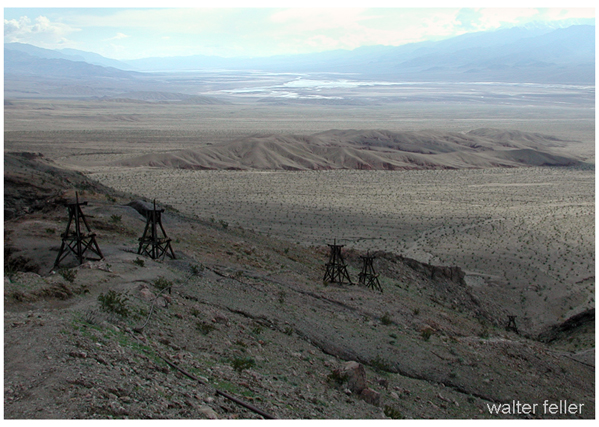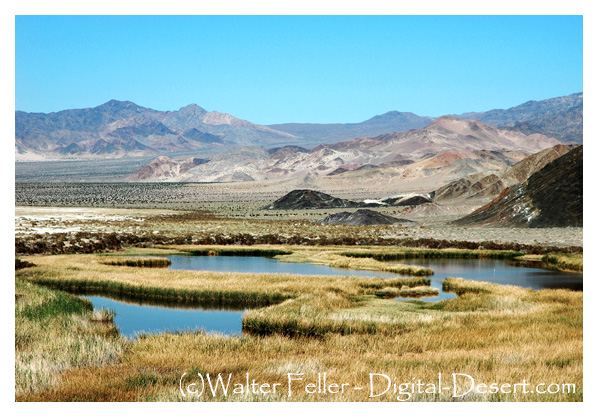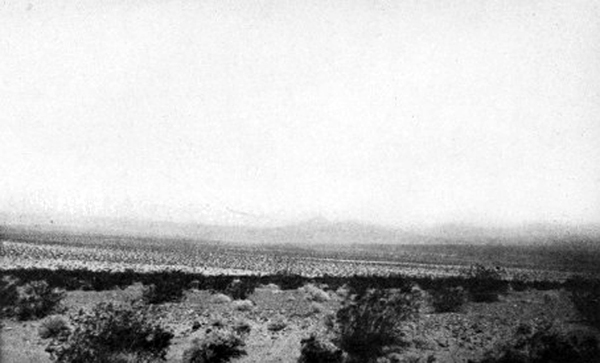Chapter VIII.
The Dry Camp
WHEN the sun stood over Tucki and the mesquites began to have real shadows beside them we resumed our journey. The little ridge which separates Death Valley from Salt Creek had looked very insignificant from the Keane Wonder Mine, but we climbed for more than an hour to cross it. It was entirely bare and covered with small flat stones of pale colors, lavender, light-blue, gray and buff, pressed down into a hard mosaic. Instead of being polished smooth the delicately-colored little stones were marked with intricate patterns which looked like the impressions of leaves and sections of plants, as though a vanished vegetation had left its record upon them. We were not scientific enough to know whether they were really fossils or whether the markings were due to the action of water or some other cause. So lovely were they that in spite of the heat which still beat up from the bright ground Charlotte and I walked behind the wagon in order to examine them. There, on that hard ridge, where not even one sickly sagebrush grew, we saw the fronds of ferns and the stems and cups of flowers finely etched.
View from the Keane Wonder
From the top of the ridge the dim wagontrack which we had been following pitched down an almost impossible hill to Salt Creek, a marsh formed by a stream that keeps itself mostly underground. Coarse grass grew in it, looking very green in the surrounding waste, alternating with streaks of white alkali. The marsh winds down from the Mesquite Valley and cuts through the ridge into Death Valley. The surrounding country is utterly barren. A little way off up the bog we could see the beginning of the sand-dunes which "Old Johnnie" had pointed out, opposite us rose the immense mesa leading up past Tucki Mountain to Emigrant Pass through the Panamints, at the left just beyond the swamp stood the harsh, red mass of Tucki, first a smooth-looking bare slope, then towering buttresses and crags of rock. Our side of Salt Creek was a jumble of little stony hills. Save for the grass and a few dead-looking mesquites in the swamp we could not see a growing thing in the whole waste.
You have to dig a well to get the water from Salt Creek. Several shallow holes had been dug where the road began to cross the marsh, and, as one was clean enough for our use, the Worrier was spared the exertion of making another. Stove Pipe Wells, near which the ring of wagons is said to be buried, is a little further up Salt Creek where some prospector once drove down a length of Stove Pipe to preserve his water-hole. All the water in Salt Creek is bitter and salty, intolerable to drink. We had thought that we might at least use it for cooking, but one taste killed that hope. We feared we could not eat potatoes boiled in it, and knew that tea would be impossible, so once more we drew upon the fifteen gallons which we had brought from Furnace Creek Ranch.
Poor Molly and Bill had no choice in the matter. They had to drink the loathsome stuff which the Worrier drew up for them from the uninviting hole. However, they seemed much pleased with the coarse, green grass, the first forage they had had since leaving Daylight Springs. Henceforth they would have to get their own living with occasional small feeds of grain, as we could not carry enough hay to last for more than another two days. By that time we should be well up in the mountains; still, remembering Beatty and the thin pickings at Daylight Springs, and looking out now over the discouraging bareness, their prospects seemed far from cheerful.
When we had located our camp as far as possible from the tin cans and ancient rubbish of other camps, the Worrier took his shot gun from under the wagon seat and went off to hunt ducks. Ducks! How could the desolation of Salt Creek, after that journey over the burning sands, yield ducks? At every green place like Furnace Creek Ranch and Saratoga Springs, we saw birds. They flashed in the sun and their twitterings broke the silence. While we unloaded the wagon that evening we saw small yellow birds like wild canaries light on the mesquites in the swamp, and many tiny blue birds; but it was hard to believe in wild ducks, even harder there than it had been at the ranch where the old Indian snooped around with his gun.

Ducks at Saratoga Springs in Death Valley - At every green place like Furnace Creek Ranch and Saratoga Springs, we saw birds.
The Worrier's assurance was so surprising that we put off getting dinner and dragged ourselves to the top of one of the stony hills overlooking the winding of Salt Creek toward Death Valley to watch him. From that viewpoint the swamp coiled between high, perpendicular, sulphur- colored bluffs like a poisonous snake glistening with green and white spots. One small blue pool far off was its eye. The Worrier was working his way toward that from grass-tussock to grass-tussock. Presently he reached it and vanished in a bunch of rushes at its edge. While we sat and waited the enchantment of sunset began. The sky became orange and green, the terrible valley that we loved and hated began to put on its sapphire robe, the sulphurous walls that prisoned the snake turned pink, the poisonous blue eye, too blue, too bright, softened—the enchanter almost had us by the throats again, ready to choke us until tears came in our eyes, when two shots spilt the spell. We sprang up, startled; we had forgotten that a man was hunting ducks in a swamp. A scramble then, back to the fireplace, a hasty match, the red fire kindled and leaping up, the smokeblacked pot balanced on the iron bar stolen from "Old Johnnie," the soft clash of tin dishes, and soon a proud hunter coming home through the sapphire night.
Early next morning we were underway, floundering across the swamp. The Worrier' fulfilled his function by doing a little worrying there, for he remarked afterwards that he might have lost Molly and Bill. Salt Creek marsh is a little sample of the giant bog that makes the bottom of Death Valley fearful. The road usually traveled to Emigrant Pass leads along the edge of the marsh and through the sanddunes before it begins to ascend the big mesa, but "Old Johnnie" had instructed us to avoid the heavy sand by keeping to the base of Tucki Mountain. There was a sort of track in some places, but mostly we ground among rocks and made detours to avoid gullies too deep to cross. The base of the mountain had looked smooth, instead it was cut by wide, deep washes full rolled-down boulders. For nine miles we skirted Tucki before we began the ascent of the mesa itself. Not till then did we pass a benchmark indicating that at last we were as high as sea-level. Except that the road around the mountain was rocky instead of sandy there was very little difference between the morning's journey and the one across Death Valley. The light and heat were intense and we suffered from the same feeling of depression. Even when we began to ascend the mesa we were hardly conscious of any relief. Though we climbed two thousand feet that day we were still on the burning sands under the pitiless sun. Everything burned, rocks were hot to the touch, the endless stony ground was a hot floor. Tucki Mountain showed a dull red as though it smoldered, and the hot blaze on the mountains beyond the great mesa was smoke rising out of furnaces.
After passing the bench-mark we were in the midst of an immense space far away from any mountains, toiling for miles up a stony barrenness where only scattered sagebrush grew. The road was so washed out that often no trace of it showed and the Worrier steered by intuition. The wagon groaned and swayed, and Molly and Bill stumbled and sweated. In the roughest places we led them. We all walked most of the day to lighten their load. A long spur of Tucki Mountain reached up the mesa several miles to the left, ending in a red promontory which we must go around, and that point became our goal. We toiled and toiled, but it was never any nearer. A quarter of an hour, a day, a year of putting one foot heavily in front of the other, and we would look up expecting some reward for so much labor, and the red promontory would be exactly where it was before.
In the afternoon we saw a cloud of dust moving. We hoped it might be wind coming to cool us, but it turned out to be a cattle outfit cutting across the mesa to our road. The dust cloud looked near, yet it was fully two hours before we met the cattlemen. The sight of the big herd of cattle on the desert was stranger than the yellow and blue birds or the fabulous wild ducks had been. They were being driven over this awful country to a spring feeding-ground in Wild Rose Canyon, and they were white with dust, limping on sore, cut feet. Two men and a boy in big hats and with pistols at their belts rode small shaggy horses, galloping through the brush and shouting when the tired cattle tried to stop or scatter at meeting us. Wild Rose Canyon was cold at this season, the men said, and there was plenty of fine water in it. "A river runs down the middle," the boy volunteered. We looked out over the shimmering mesa stretching hopelessly in all directions. A canyon called Wild Rose where a river flowed between the mountains!
We inquired further into the fairy tale. The Canyon was about forty miles away by the route which we would have to take with the wagon. It led up into the high Panamints. There was a spring by some old charcoal-kilns right under Mt. Baldy. The cattlemen knew nothing of Telescope Peak. They had never heard of any one climbing the mountains. They supposed it was easy enough when the snow was gone. No doubt prospectors had been up, but there was nothing there, it was no good. We saw them eying the Worrier curiously, evidently wondering what manner of creatures he had managed to pick up.
After a mile or two they left us, turning off by an ancient signboard pointing vaguely toward the long, red spur of Tucki Mountain with the legend: "Water Eight Miles," and in the opposite direction across the trackless, torn-up waste: "Water Fifteen Miles." What are eight miles or fifteen miles to the modern man accustomed to leap over distance? To the primitive traveler with horses and mules, and until now all travelers throughout the ages have been thus primitive, a mile is a formidable reality. Mojave teaches the truth about it. At the end of those two days, that "Water Eight Miles" was as inaccessible to us as though it had been fifty. Even if we had been full of vigor we probably could not have reached it with the wagon over that rough ground. The cattlemen, however, on their tough little horses, went to it. We did not attempt to leave the two dim streaks that occasionally marked our road, but at dusk stopped and made camp beside them.

The desert
That was our first genuine dry camp, though it was the third time we had depended on the water carried from Furnace Creek. Water is the commonest of all commodities, so common that we fail to realize its meaning until we are without it. All the camps thus far had been resting-places, homes. We had come to feel that any spot where we built our fire could be home, for the essentials of home are very simple; a little water, something to eat, a bit of fire, and good friends. In the mess at Keane Wonder, in the forbidding inhospitality of Salt Creek, we had had them all and been at home; but that night, when the Worrier began to unload the wagon in the stark middle of the solitary waste, we were not at home. Nor could we make it home, however brightly we urged up the fire or cheerfully we talked. One of the essentials was missing and the gasoline cans could not take its place. No water, not even bad water, not a drop! That mesa was not a human resting-place; we were aliens in it, transients, one-night-standers. The Worrier laughed at our restless forlornness. On subsequent travels we have learned to make dry camps almost as nonchalantly as he does, but they are never home.
In the hot miles between Furnace Creek Ranch and the mountain-spring we learned the meaning for our little lives of the commonest of commodities. We had never been so thirsty, no amount of water could satisfy us, and the supply was limited. We had enough for all our needs, yet we never could forget that there was an end to it. When the jolting of the wagon slopped some out around one of the corks we could have wept. Using any for cooking or washing dishes, and pouring out ten gallons for Molly and Bill at the dry camp seemed terrible. Until then we had thoughtlessly turned on a faucet, or drawn a bucket from a well, or dipped water out of a stream. Now there was no water. The miles were not only hot, they were dry miles. The diminishing supply of warm, unattractive liquid in the dented gasoline-cans was our most precious possession. We would have parted with everything we had, rather than lose it.
From the camping place the red promontory looked as far away as it had been at noon; we seemed to have made no impression on our goal. Below us the Mesquite Valley spread out, immense and still, with the green thread of Salt Creek crossing it. On the far side rose the Grapevine Range, of which Corkscrew Mountain is the southern end. The evening air was so clear that we could see the spiral cliff and the opening of the canyon that leads to Daylight Pass. It looked very near, yet how many days'- journeys we had come from there! Heat and thirst and weariness lay between. The grimness of Death Valley, cool now in the shadow of the Panamints, was hidden by the buttresses of Tucki. The long line of sultry red rock that had smoldered and smoked all day slowly turned blue in the twilight. It seemed as though you might saunter over there and lay your hands upon it, yet the signboard pointing to the water at its base had read eight miles. We had long lost sight of the cattlemen. Suddenly, in the dusky blueness under the mountain, their camp fire bloomed like a crimson cactus flower.
Evening smoothed the whole mesa into a blue and yellow floor rounding gently the mountains. It was impossible to believe that it was everywhere cut into hills and canyons by washes fifteen or twenty feet deep as it was around our camp. In the bottoms of the declivities large greasewoods and cacti grew, and occasional tufts of dried grass; but the wind-swept ridges were bare and every particle of sand was blown away from among the stones. On one of the beaten-down mosaics near our camp something gleamed dimly. We went to it and found large white stones laid in the form of a cross pointing toward the east. Another traveler, then, had stopped here. Perhaps he had looked at the red promontory and the spiral cliff and lost hope; perhaps he had prayed for water; or perhaps he had made it as a thank-offering for the blessed coming of cool night.
Previous -- Next
Contents
I. The Feel of the Outdoors
II. How We Found Mojave
III. The White Heart
IV. The Outfit
V. Entering Death Valley
VI. The Strangest Farm in the World
VII. The Burning Sands
VIII. The Dry Camp
IX. The Mountain Spring
X. The High White Peaks
XI. Snowstorm and Sandstorm
XII. The End of the Adventure